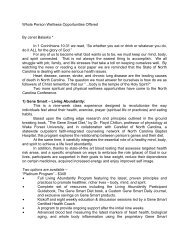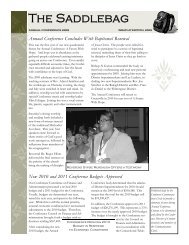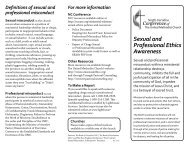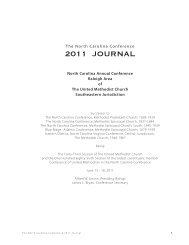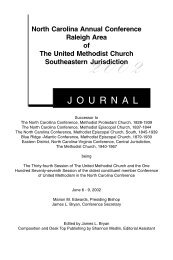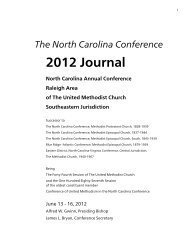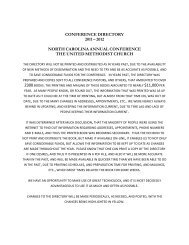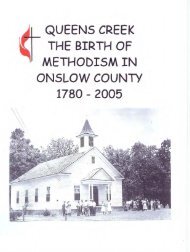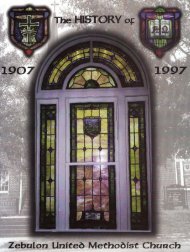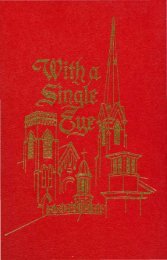OUR LEGACY FROM THE PAST - NCCUMC
OUR LEGACY FROM THE PAST - NCCUMC
OUR LEGACY FROM THE PAST - NCCUMC
Create successful ePaper yourself
Turn your PDF publications into a flip-book with our unique Google optimized e-Paper software.
86<br />
CENTENNIAL CELEBRATION -1928 & 1929<br />
The following address was delivered by Dr. O. P. Fitzgerald,<br />
pastor 1927-1928,on the occasion of the Centennial Anniversary of<br />
Methodism in First Church, Williamston, North Carolina,<br />
February 22, 1928.<br />
HISTORICAL SPOTS OF<br />
WILLIAMSTON METHODISM<br />
When John Wesley began his revival of religion in Oxford,<br />
made a brief missionary stay in Georgia, went back to England to<br />
undergo his great spiritual awakening which he afterward called<br />
his conversion, and then began the greatest revival of religion<br />
England ever experienced; it was the Rev. George Whitefield, colaborer<br />
with Wesley, who crossed and recrossed the Atlantic,<br />
sweeping up and down the American Colonies with his inspiring<br />
eloquence, moving like a flaming fire from Maine to Georgia,<br />
opening men's hearts, melting their wills and changing their lives.<br />
Whitefield's work in America was almost a religious movement<br />
within itself. Robert Williams and John King took up his work in<br />
Virginia and North Carolina, and formed Methodist Societies in<br />
these states. Then came Francis Asbury, delegated by John<br />
Wesley to be the assistant superintendent over the new formed<br />
societies. Asbury was afterward elected Bishop, and for fifty<br />
years this remarkable man, great in character and ability,<br />
unwearied and unceasing in travel and preaching, led and<br />
governed the growing hosts of Methodism in America.<br />
At the close of the Revolution, the strength of Methodism was<br />
centered in Maryland, Virginia, and North Carolina. From these<br />
older states went forth her evangels as religious pioneers to the<br />
South and West. No settlements were too sparse, no road too<br />
rough, no wilderness too wild for the itinerant Methodist<br />
preacher. They rode forth confident of their message, trusting in<br />
God, unafraid of man or beast. The "circuit rider" is, doubtless,<br />
the most significant figure in the religious movements of the<br />
South. He was a strong, stern man, repressing fun and gaiety as<br />
worldly pleasures dangerous to the soul; with no worldly goods<br />
save that which he carried on his back and in his saddle-bags,<br />
breaking the stillness of the forest with his prayers as he rode to



